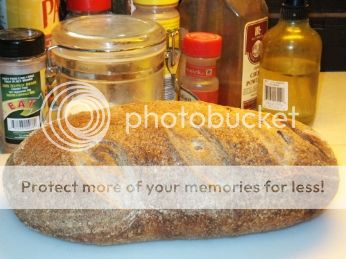Late last year, I posted about the availability of Green River Organic Whole Wheat flour at a KC, MO Costco. I thought organic, stoneground, and $8 for a 10 pound bag might be of interest to others who live in the KC area and have access to a Costco. PMcCool was the first to post that he had purchased a bag and enjoyed both working with the flour and consuming the results of his labors.
After purchasing a bag of my own and reading Paul's posts, I got motivated to work with the flour myself. Paul noted that the flour is particularly thirsty so I decided to temporarily lose my apprehension about working with higher hydration doughs and just go for it. After all, being a raggedy home baker allows me the excuse of not having to be perfect in style, procedure, and execution. I can learn from flops or bricks and not have to worry about the costs.

This turned out to be a pretty good loaf. Essentially, it's a 67% bread flour/33% Green River whole wheat at around 74-75% hydration. Since the room temperature was around 70F while I was working it up, the dough moved slowly, requiring about three and a half hours for the bulk fermentation and another four for the proofing. I think it could've used more time proofing.
Anyways, it all turned out very well for the first time around with new flour. It was a moist crumb with just a slight bit of that whole wheat sharpness to the flavor. My starter isn't particularly zippy in flavor because its refrigerated until needed so we weren't overwhelmed with sour. It definitely was worth repeating as a formula but the next time was different and a good lesson inwatching the needs of the dough.
When I started my mixer on Thursday, the room temperature was already 84F. The starter had leapt into a vigorous fermentation during the day. Bulk fermentation took about two and a half hours instead of four which was a good thing. It meant I could go to bed at 1200AM instead of 1-130AM. I always clean up after flinging flour in the kitchen.

An overnight proofing in the fridge didn't hurt the loaf at all. I let it sit on the counter for an hour and a half while eating lunch and preheating the stone. The resultant loaf is better than the first attempt but by no means as polished as I'd like. The appearance isn't perfect but I'm still experiencing the Carnegie Hall Syndrome, practice, practice, practice.

So now, the real work on this loaf begins. I feel like I ought to gather my notes, both written and mental, to organize into a coherent formula rather than just a sketch as exists now. Until I can present instructions that someone half way around the globe can utilize, this formula isn't complete. For the gluttons for punishment among us, I have posted some disjointed and trivial ramblings on my blog site about these two loaves. Prior substance abuse isn't required before reading.
http://chaosamongstthefloursandflowers.blogspot.com/